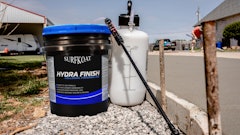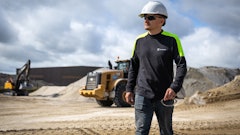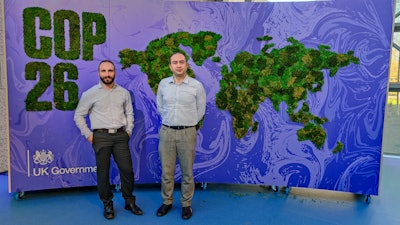
After water, concrete is the most consumed material in the world and accounts for 8% of global CO2e emissions. However, Concrete4Change Ltd. (C4C) is on a mission is to enable the concrete industry to transition from CO2 emitters to CO2 sinks, by developing a technology capable of removing significant amounts of CO2 from the atmosphere and absorbing it into concrete. Concrete4Change was a winning project in the Achieving Net Zero category of the 2021 UN Climate Challenge Cup.
The Cup shortlisted 12 finalists that showcased their projects during COP26. Awards were categorized in Achieving Net Zero for "projects that are helping reduce emissions at a local or regional level" and Climate Change Adaption for "projects that are working with communities in regions affected by climate change to mitigate or adapt to the effects it is having.
The Green Era Renewable Energy and Urban Farm Campus project from Chicago won the Climate Change Adaption category - a project that transformed a vacant 9-acre site into a renewable energy and farming site creating 25 jobs and diverting inedible food waste from landfills.
Additional Finalists in the Achieving Net-Zero Category:
- The Texas Carbon Market - Landowners like farmers and ranchers would "rewild" a portion of land to absorb and store carbon in the soil.
- Producing Food on Chalk Soil - The UK's Department of Environment, Food and Rural Affairs analyzed the practice of growing food on a farm using chalk soil, trapping carbon in the process.
- Transitioning the Appalachian Region - An investment project creating The Marshall Plan for Middle America to "revitalize communities, create family-sustaining jobs, advance a clean and just transition, and invest in the future of local people." According to the plan, the area stands to gain 410,000 plus new jobs.
- The Net Zero Innovation Programme - Universities and local authorities around the UK were brought together to share resources and knowledge in the design and implementation of various innovation projects.
- UK Food & Drink Supply Chain - The Sustainable Futures Carbon Bank, which is being piloted in Yorkshire, aims to incentivize more farmers to use some of their land for sequestering carbon.
Additional Finalists in the Climate Change Adaption Category:
- Heat Equity Analysis, Bus Shelters - A survey done in the Sun Valley area (Los Angeles) inquired citizens about the state of and use of bus shelters.
- Climate Adaption Tool - The project featured the creation of an online "Local Climate Adaption Tool" allowing decision-makers to view climate forecasts up to 2090.
- Mapping the River Clyde - The Hidden Environmental Histories of the River Clyde project examined the history of the river, its environmental impact, and the creation of a "story map" to explore the climatic and environmental influences.
- Preventing Pittsburgh's Landslides - After spending $12 million cleaning up landslides, the city of Pittsburgh developed a pilot project in the creation of services and organize projects the city and volunteers could participate with.
- Climate Policy in South Florida - The Southeast Florida Regional Citizen Science Climate Action Network project trained citizens and students in the gathering of data on flooding and heat. Findings are to inform policy and address challenges across the region.
What is Concrete4Change
The sequestration of CO2 results in the strength enhancement of concrete; therefore, reducing the amount of cement required to produce equivalent-strength concrete. Both CO2 sequestration and cement reduction can contribute to the reduction of concrete’s CO2 footprint. This technology has the potential to mitigate 2 billion tonnes of CO2e emissions, the equivalent of 4% of global CO2e emissions.
Aimed at the structural, non-structural, ready-mix and pre-cast systems, Concrete4Change (C4C) utilizes a polymer to transfer 30% of CO2 into concrete, permanently mineralizing the gas and increasing the strength of the concrete. While concrete naturally absorbed CO2, the C4C innovation is designed to make this process more efficient.
The School of Engineering and WMG center High-Value Manufacturing Catapult at the University of Warwick are supporting C4C by undertaking essential testing for the company with the help of funding through Innovate UK and the DI4M program.
“As the world strives to reach zero-carbon goals, the construction industry and we civil engineers have a huge role to play to make concrete more sustainable. The cement we use to produce concrete contributes massively to CO2 emissions, and therefore we need to take drastic action now if the construction sector is to achieve its CO2 reduction goals. Here, at the School of Engineering, we are incredibly excited to support Concrete4Change by performing concrete technology and durability tests, which are critical to prove that the technology can be safely adopted by designers, contractors and concrete producers.”
—Dr. Reyes Garcia, The School of Engineering, University of Warwick
“In order to make sure the concrete made by this innovative technology is as good, as if not better than previous standards we will be assisting Concrete4Change by completing testing and microscopical examination. Once testing has been completed the partnerships that C4C have made can help bring this technology to market and reinvent the concrete industry into a more sustainable and eco-friendlier one.”
—Dave Myers, WMG SME group, University of Warwick
Concrete4Change has built partnerships with other leading academic institutions as well as with some of the largest concrete producers in the world including Hanson Heidelberg, Kier, SIG, Morgan Sindall, and Skanska. According to Dr. Sid Pourflah, founder and SEO of Concrete4Change, the organization has also been selected by the Brazilian Ideiagov as one of the top 10 companies to tackle Latin America's Net-Zero Challenge, by the British Precast Federation as one of the top 3 most innovative companies, and as one of the top 5 companies for Knowledge Transfer Network Transforming Foundation Industries.
The School of Engineering at the University of Warwick strives for significant impact to make the world a better place and has built an international reputation for excellence in teaching and research, with courses accredited by the key engineering institutions in the UK including the IET, IMechE, IStructE, and ICE. The academic and research staff work with industry and partner organizations to conduct enquiry-driven, fundamental, and pioneering research.
WMG is a research and education group, transforming organizations and driving innovation through a unique combination of collaborative research and development, and pioneering education programs. WMG develops advancements nationally and globally, in applied science, technology and engineering, to deliver real impact to economic growth, society, and the environment.










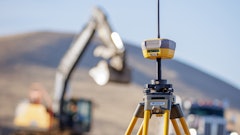



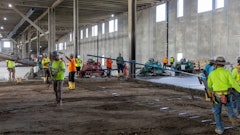

![Fcp Racatac Chair 10893876[1]](https://img.forconstructionpros.com/mindful/acbm/workspaces/default/uploads/2025/10/fcp-racatac-chair-108938761.10l0At5WXv.png?ar=16%3A9&auto=format%2Ccompress&bg=fff&fill-color=fff&fit=fill&h=135&q=70&w=240)

